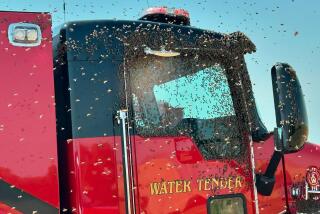Editorial: Want to help the bee populations? Grow a variety of flowers
The European honey bee was brought to this continent in the early 1600s, but not to pollinate crops. Rather, early settlers sought beeswax to make candles. Native bees, which are mostly solitary ground-dwellers, were effective pollinators but did not provide significant quantities of wax or honey.
It wasn’t until the 1980s, when large-scale industrial farming began to replace family farming, that the honey bee became important to agriculture. Instead of a mix of crops grown on smaller plots, often separated by hedgerows, a single crop would be grown on vast stretches of land. Masses of flowers were blooming all at once, requiring an influx of pollinators.
Enter the honey bees, a convenient fit for this sort of farming. They form huge colonies that can be transported into the middle of a field while a particular crop is blooming.
But how has the European honey bee — a non-native species associated with industrial agriculture — become a darling of the U.S. environmental movement? Credit the drastic increase in colony collapse disorder, a phenomenon in which most of the worker bees disappear from a hive. It has raised farming costs, caused consternation among scientists and government agencies, and given rise to a back-to-nature movement of people trying to save the bees by establishing hives among high-rise rooftops and suburban backyards, including in Los Angeles.
But the European honey bee is not facing extinction. Yes, too many hives are lost each year and no clear solution is in sight, but beekeepers are able to replace those colonies through a process called hive-splitting. Bee losses have actually declined significantly in recent years, though they rose again this year. In any event, amateur hive-tending isn’t likely to make a big difference to the honey bee’s future, experts say; backyard hives are twice as likely to fail as commercial ones.
Unfortunately, the single-minded focus on European honey bees — on banning certain pesticides, for instance, or allowing backyard beekeeping in Los Angeles, which the City Council is on the verge of doing — has obscured the importance of native bees. Few people are even aware that they exist, yet there are 1,500 species in California alone. Provided with the right habitat — a variety of flowering plants that aren’t sprayed with pesticide — they’ll thrive in the ground or in holes in pieces of wood. They’re easy neighbors: prolific pollinators that don’t swarm. Most of them don’t sting, and they don’t suffer from colony collapse disorder. They come in all kinds, from the metallic emerald of the ultra-green sweat bee to the fuzzy black-and-yellow California bumblebee that excels at pollinating tomatoes. And they need help; dozens of species nationwide are in danger of extinction from loss of habitat.
Because these bees are largely solitary ground-dwellers, they can’t be shipped en masse to a flowering agricultural field. Yet they can help solve the honey bee problem. Research has shown that farms would need to make only modest changes to attract healthy numbers and varieties of the local pollinators. Bees, both honey and native, need continual sources of food — i.e. flowers — while monocrop agriculture provides flowers for only a short period. Planting a few different crops with different flowering times would make a major difference, research has found. Better yet, planting the perimeters of those fields with old-fashioned hedgerows — narrow rows of wild shrubs — has been found to provide ample habitat for native bees.
Such changes would be good for honey bees as well. If they feast on only one crop, says UC Berkeley bee researcher Claire Kremen, they are more likely to have nutritional deficiencies that contribute to hive collapse. An analysis of crops worldwide found that when native bees coexist with honey bees, production increases substantially.
As Los Angeles moves toward its own beekeeping ordinance, the council should consider this: If the goal is to strengthen the bee population — both native and European — the best strategy is to give residents incentives to grow more flowers and avoid treating them with pesticides, entomologist Marla Spivak says. It’s the perfect message for these drought-troubled times anyway, when homeowners are replacing lawns with native plants. It won’t provide artisanal honey, but it will promote healthy bee populations, including hundreds of species that won’t swarm or sting.
Follow the Opinion section on Twitter @latimesopinion and Facebook
More to Read
A cure for the common opinion
Get thought-provoking perspectives with our weekly newsletter.
You may occasionally receive promotional content from the Los Angeles Times.










